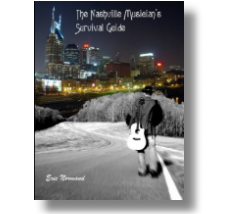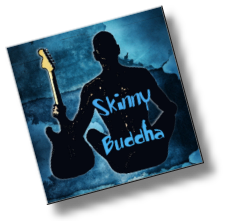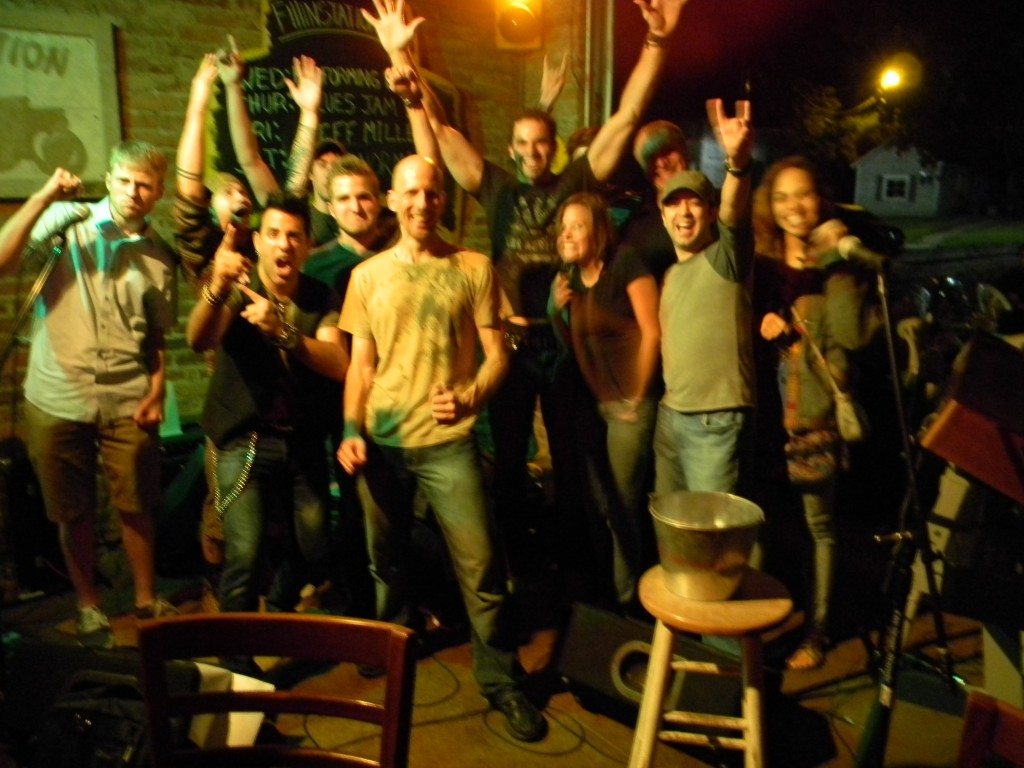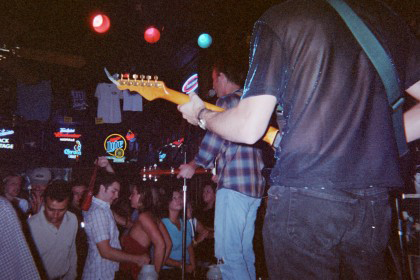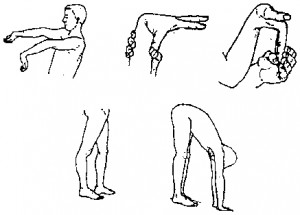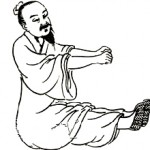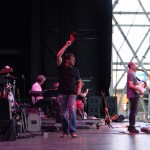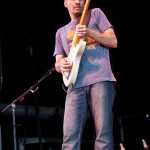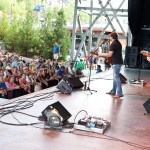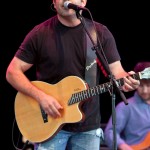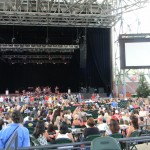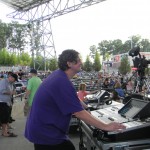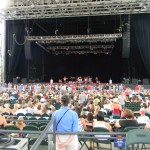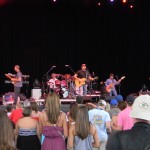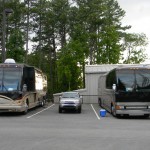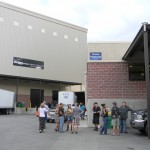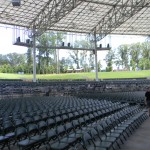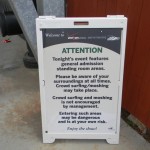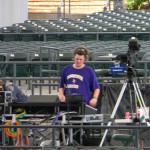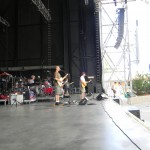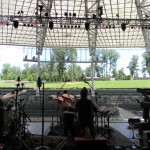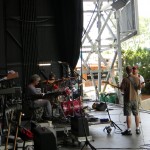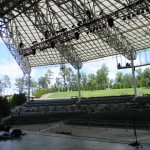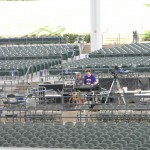
By Eric Normand
What an amazing run of shows we had with Rhett Akins and Dallas Davidson on the forth installment of the Luke Bryan Farm Tour! The sold out tour embarked on eight shows across the Deep South, with Rhett and Dallas performing acoustically on the first four, and me and the boys joining in for full band performances on the second leg. The weather for these events was picture perfect, the crowds were huge, and the shows an amazing encapsulation of kinetic energy!
Me and the rest of the band (Nick Forchione on drums and Tom Good on bass) converged at a bus yard in Nashville on Tuesday night and hopped on Luke’s band bus. You never know what to expect in these situations, (as the two bands began this run as total strangers) and we were pleased to learn that Luke’s band and crew are some of the nicest people you could ever hope to work with. Gracious hosts, they made us feel instantly at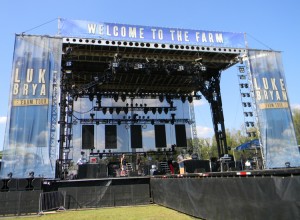 home.
home.
After a good night of sleep on a smooth riding Prevost I awoke in Villa Rica, Georgia. This first show was on a football field, and by the time I wandered over to catering around 10 AM the mobile stage was already up, the field buzzing with activity. Luke went all out on the production for this tour, and there were no less than eight buses accompanying the five semi’s full of staging, audio, lighting, video, and pyro it took to put on these mega-shows.
I was thrilled to find out that there were some other health-conscious folks in Luke’s entourage, and me and Nick joined several of Luke’s band-mates on a trip to the fitness facilities at the University of West Georgia. By 4 PM the stage crew was ready for our sound check, quickly dialing in our in-ear monitor mixes and a bigger than life sound through the mains of the million-dollar Claire Brothers sound system. As a guitar player, I’ve always struggled with in-ear mixes, lack of warmth and ambience being my main gripes, but on this lucky day I learned a new trick. Upon the suggestion of the Claire Brothers monitor engineer, we put a little reverb on my guitar in my ear mix, and this created some extra depth.
Later that night and after the first two openers, Chancie Neal, and Cole Swindell, we took the stage for the first full-band show with Rhett and Dallas. As members of the red-hot songwriting team known as “The Peach Pickers”, Rhett and Dallas have 13 number one songs and countless top 20 hits between them, including a few of Luke’s recent hits “Rain Is a Good Thing”, “Country Girl Shake It for Me”, and “I Don’t Want This Night to 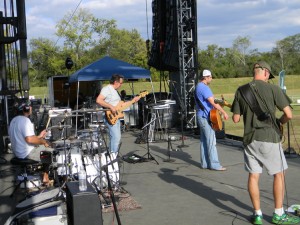 End”. This fact makes it pretty easy to create a blockbuster 45 minute set which included Blake Shelton’s “All about Tonight“ and “Honeybee”, Rodney Atkins’ “Farmer’s Daughter” and “Take a Back Road”, and the Trace Adkins chart topper “Honky Tonk Badonkadonk”, among others. At times the crowd was singing along at a volume that was as loud, if not louder than the band! The action-packed set went by at warp speed, and it seemed like no sooner than we had started we were walking off the stage.
End”. This fact makes it pretty easy to create a blockbuster 45 minute set which included Blake Shelton’s “All about Tonight“ and “Honeybee”, Rodney Atkins’ “Farmer’s Daughter” and “Take a Back Road”, and the Trace Adkins chart topper “Honky Tonk Badonkadonk”, among others. At times the crowd was singing along at a volume that was as loud, if not louder than the band! The action-packed set went by at warp speed, and it seemed like no sooner than we had started we were walking off the stage.
The stagehands helped us get our gear off the stage and by 9 PM our workday was done. A short workday is characteristic for an opening act on a major tour – you’re the last to sound check and the first to play. Now it was Miller time, or in this case “Coors time”, or for a few of us “Crown Royal time”! After a quick cocktail and a little chill time on the bus we went out to check out Luke’s show. The level of musicianship in Luke’s band is nothing short of exceptional, and their 90 minute set was a rocking good time with some stunning visual aspects as this night was a dress rehearsal for the following show which was being taped for a television special.
The following day I awoke and looked out the bus window to the view of an open, grassy field in Athens Georgia – this concert was actually taking place on a real farm! After a little morning chow I decided to take a jog down some of the surrounding roads of this picturesque farming community, Rhett’s song, “Take a Back Road” having some real relevance on this warm autumn day. The day evolved similarly to the previous and the ultra-professional crew did an outstanding job erecting this mega-production in less than ideal circumstances. I later learned that the 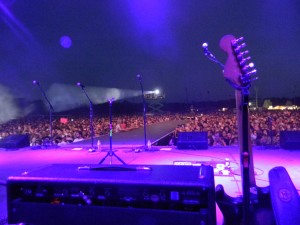 stagehands on this particular tour traveled from show to show (unlike many touring situations where stagehands are local to each venue) and this creates a continuity that helps the production run smoothly. The performances on this night went off without a hitch, with all of the bands delivering outstanding performances. Luke’s show was filled with special visual effects for the filming of the television production – including a laser show, pyro, and a massive finale of fireworks to end the night.
stagehands on this particular tour traveled from show to show (unlike many touring situations where stagehands are local to each venue) and this creates a continuity that helps the production run smoothly. The performances on this night went off without a hitch, with all of the bands delivering outstanding performances. Luke’s show was filled with special visual effects for the filming of the television production – including a laser show, pyro, and a massive finale of fireworks to end the night.
The next day would find us in Tallahassee, Florida and I joined up with some of the guys to go work out at the fitness facilities of Florida State University. After a great workout at a great facility we were ready to get back for some lunch, but not before winding up in a “runner altercation”. The runner informed us that he needed to stop at Lowe’s to get some stage pins for the production crew. Of course they didn’t have what he was looking for and sent us to another store that didn’t have it either. An hour and a half later we caught a lucky break at a John Deere tractor store and were finally heading back to the venue with the necessary part, and some growling stomachs. Another sold out show, another night of great performances and we were off to the tour’s grand finale in Macon, Georgia.
As Luke’s buses were returning to Nashville after this final show and we were going on to play one more show with Dallas and Rhett at the Georgia Throwdown in Dallas’ hometown of Albany, Georgia (a festival that Dallas helped organize), we had another bus arriving in Macon late morning. After the bus arrived we loaded our stuff onto it and continued about our day. As Macon is home of the final resting place of Duane Allman and Berry Oakley, a couple of us took the mile and a half walk to the Rose Hill Cemetery, a place from another world where a young Allman Brothers Band once played guitars, wrote songs, and partied into the hot Georgia nights.
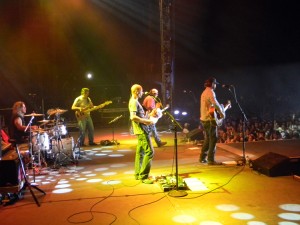 Later on we took the stage in front of 16,000 fans for a final, climactic performance on this epic tour. I’ve played countless big shows over my decade in Nashville, but on this particular night a special energy was present. The songs just seemed to play themselves and the crowd was singing every chorus (and many verses) at a near deafening volume. At one point I pulled out one of my in-ear monitors to really internalize the feeling of the moment. As a musician it’s almost otherworldly to hear and feel your guitar coming out of 100,000 watts or so of PA speakers, and to feel the interaction between artists, band and audience on a show at this level is truly amazing! Our band was really on and Rhett and Dallas were at the top of their game, putting on a dazzling show for what looked like a sea of humanity that stretched to the horizon.
Later on we took the stage in front of 16,000 fans for a final, climactic performance on this epic tour. I’ve played countless big shows over my decade in Nashville, but on this particular night a special energy was present. The songs just seemed to play themselves and the crowd was singing every chorus (and many verses) at a near deafening volume. At one point I pulled out one of my in-ear monitors to really internalize the feeling of the moment. As a musician it’s almost otherworldly to hear and feel your guitar coming out of 100,000 watts or so of PA speakers, and to feel the interaction between artists, band and audience on a show at this level is truly amazing! Our band was really on and Rhett and Dallas were at the top of their game, putting on a dazzling show for what looked like a sea of humanity that stretched to the horizon.
A little while later Luke and his boys played their final show of the Farm Tour, and their epic performances received over-the-top responses after each song. When the show ended all of the artists, musicians, and crew members gathered on the stage for a group photo of the entire entourage. I was sad to see this run end, but we left for Albany with the knowledge that we made a lot of people happy over the course of this week, and we had also made some great new friends! See you next year, Farm Tour!
To view a slideshow of some pics from the tour click here.
Today I want to tell you all about an exciting monthly event I have been hosting – The Nashville Berklee Jam, and its new accessibility to everyone in the Nashville music community. The beginnings of this idea came to me a few years ago when I first attended the annual Nashville Berklee Alumni Reception. On my way home that night, I remember thinking how great it was to meet so many musicians in one night who were so passionate about their musical ambitions and so hungry for knowledge. These musical comrades were a mix of Berklee alumni residing in middle Tennessee and Berklee students who came down for the annual Nashville field trip. At this reception I made connections with other like-minded alums and students who came down on the field trip, the latter peppering me with questions about my experiences in Music City. This event was a very stimulating night as the energy of three hundred musical minds meeting and conversing seemed to create an air of camaraderie and untapped potential! Then I went home and another year passed before I got this fix again.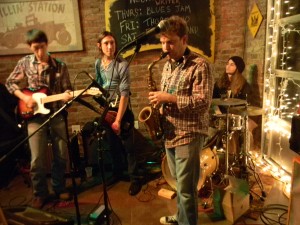
So this past winter I decided to create a monthly event to try to emulate this musical networking hoedown on a smaller scale, and The Nashville Berklee Jam was born. Held on the first or second Tuesday of the month from 7 PM to 11 PM at The Fillin’ Station in Kingston Springs, TN, these events start out with an informal meet and greet, followed by a Nashville music industry guest speaker, and end with an open jam. So far the reception has been very positive, here’s a recap (with links to their corresponding blogs):
February – A-list session bassist, Mike Chapman gave a great talk about being a session musician, outlining key concepts in what he calls, “the essential slices of the session player pizza”. He also jammed with several alums after the talk.
March – award-winning vocal coach, producer, and hit songwriter, Judy Rodman gave an insightful talk about career paths for vocalists. She also performed a couple of songs with the house band and then critiqued and coached several vocal performances, helping vocalists make instant improvements.
April – Stevie Ray Vaughan keyboardist, Reese Wynans shared his fascinating story about being a lifelong-career musician, the life-changing moment that came on his last night with Delbert McClinton that landed him the SRV gig, and the whirlwind years that followed. After his talk, he joined us for a few inspired performances.
May – fellow alum, musician, and author of “The Nashville Number System”, Chas Williams gave an introductory class on this subject. After the class, he charted one of alum, Sarah Tollerson’s originals and performed it with Sarah and the house band with everybody reading the chart off a dry erase board.
June – drummer, producer, and clinician, Rich Redmond gave an inspiring talk on “Navigating the Nashville Music Industry” speaking candidly about his early “lean years” in Music City and different approaches to finding success here. After his talk he sat in for a few tunes and stuck around to chat with others in attendance.
For our next event, to be held on Tuesday, July 10, I will be giving a talk that continues last month’s theme – “Navigating the Nashville Music Industry – Part Two”, during which I will explore some of the concepts I write about in my book “The Nashville Musician’s Survival Guide”. And, this just in, for our event in August we are proud to announce that the guest speaker/performer will be none other than Nashville guitar ace, Jack Pearson, formerly of the Allman Brothers, Vince Gill and many others.
All of the guest speakers have given great talks, sharing their knowledge and providing inspiration, and these talks have been interactive with many great questions and comments from alums. My band, Skinny Buddha (comprised of Berklee alumni and others from the Nashville music community) provides backline and a starting point for the laid back jams which have covered everything from originals to classic rock to blues tunes to two-chord jams. All of these events have been great friendship building and networking experiences for all involved, as well as educational. So far, the attendance has been mostly comprised of Berklee alumni, but as there seems to be a growing interest from others in Nashville, we are now officially making this event open to the Public. Nashville is a diverse and complex music community in which a Berklee alumni community also resides, and it is my goal to help these two worlds intersect and meld together.
So come on out to our next “Nashville Berklee Jam” On Tuesday, July 10. I hope to see you there!
P.S. if you have any comments, thoughts, or questions, please feel free to e-mail me at eric@ericnormand.com.
Even though the majority of the people who come to Nashville for CMA week are country music fans, you didn’t have to be one to enjoy the BMI songwriter showcase-tailgate party yesterday at LP Field. This unique event was as much a foot stompin’ rock concert as it was country music show, and the crowd of 3000 plus concertgoers received a rare treat on this warm, sunny afternoon. 2011 EMI songwriter of the year, Rhett Akins, and 2011 BMI songwriter of the year, Dallas Davidson, also known as the Peach Pickers, have written some of the biggest chart-toppers in recent country music history, and collectively have more hits songs currently on the radio than any of the major artists they write for.
As professional songwriters, they sit in a room with their acoustic guitars daily, writing hundreds of songs a year to come up with a handful of radio-bound gems. These songwriting sessions, and the demo recording process that follows, are quite often the first and last times they get to perform this music. So this rare occasion to play the hits they wrote in front of a large audience was as much, if not even more of a treat to the Peach Pickers as it was to anybody in attendance.
The hour-long show was off and running with the number one hit cut by Blake Shelton, “All About Tonight”, a fitting start for this musical adventure. Rhett and Dallas took turns singing verses and choruses as we moved through what was essentially a “greatest hits” of modern country radio music, including the six number ones they’ve written in recent years. The crowd sang along throughout the show as we put our own twist on songs like Honeybee, Take a Back Road, Gimme That Girl, Put a Girl in It, Honky-Tonk Badonkadonk, This Ole’ Boy, and several others.
Near the end of the show, Rhett unexpectedly pulled out a couple of surprises, performing his own hits “That Ain’t My Truck”, and the showstopper, “Kiss My Country Ass”. At a few different points throughout the show, Rhett gave credit to the band which was comprised of Nick Forchione on drums, Mike Chapman on bass, Scott Tweten on guitar, and me on guitar and harmony vocals, the excited crowd responding with cheers of approval every time. We concluded this blockbuster set with the fitting “I Don’t Want This Night to End” a number one song which was cut by Luke Bryan and had just won video of the year the night before.
The truth is that none of us wanted this night to end, it was a special moment and the unique nature of this show will make it one of the more memorable things I have been a part of in my 10+ years working in the Nashville music industry. But the good news is that we will be taking this show on the road a little later on in the summer, performing at Michael Waddell’s annual Bone Collector fan club party on August 17 in Montgomery, Alabama. I want to send out a special thank you to all the fans that came out for this show, and everybody who put in a lot of hard work behind the scenes to make this event the huge success it was. Till next time, “it’s all about tonight”!
Click here to view some photos from the show (courtesy Kelly Normand)
For more in-depth perspective on the behind the scenes of the Nashville music industry, please check out my book “The Nashville Musician’s Survival Guide”, which features an in-depth interview with Rhett as well as many others Nashville insiders.
The latest Nashville Berklee Jam last Tuesday was a great success, thanks to all who attended! The weather was beautiful, so we had a very laid back talk outside on the patio at The Fillin’ Station, our usual location for this event. Rich Redmond, the guest speaker on this night, has worn a lot of hats during his 15 years in Nashville – session/touring drummer, producer, clinician, public speaker, and his hour-long talk gave all in attendance some great perspective into different ways to navigate the Nashville music industry.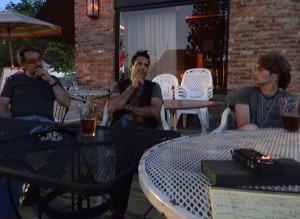
Rich spoke of the need to aggressively market yourself to find work in Nashville and how in his earliest days he obtained work by handing out demo cds of his drumming abilities to almost everyone he would meet around town. He candidly talked about those ‘lean years’, and that long before he was recording on hit records, touring the world with Jason Aldean, and producing acts like ‘Thompson Square’, he was hustling gigs on Broadway, playing in corporate party bands – whatever was necessary to insure survival.
For those who are just starting out in Nashville, he recommended that musicians “take every gig that’s offered”, as every new gig can potentially lead to new relationships and different career opportunities and that “If you give more to people then they expect, if you consistently exceed expectations, people are going to want to work with you.”
He spoke of the need to be ultra-professional by “always returning phone calls in a timely manner, always returning e-mails in a timely manner, being professional, being flexible, having the right gear to do the job and never mailing in a performance…”
Regarding the importance of reputation he said “You can have a great website, you can Tweet 1000 times a day, you can have a fantastic business card that’s got the really good paper, you know the really firm stuff that you have to pay extra for, and it’s still going to come down to word-of-mouth. In this [digital] age it’s so easy to be talked about in a positive or negative way, globally.”
During one part of the talk he mentioned a concept he refers to as “CRASH” a phrase he coined that stands for Commitment, Relationships, Attitude, Skill and Hunger – the five key ingredients he believes are necessary to succeed. He also spoke of the importance of defining your own success, a concept I talk about in my book “The Nashville Musician’s Survival Guide” (coincidentally, Rich contributed to the writing of this book).
After fielding several questions, he finished his talk and we all headed inside to make some music. Everyone who wanted to jam got a chance to sit in, and several great performances took place – ranging from classic rock covers to blues jams to originals. Rich stayed till the end making himself accessible to anyone who wanted to hang and chat, and during the middle of the jam he got behind the drum kit and played a few songs with me and several other alums. Here’s an MP3 of us playing a spirited version of the Jimi Hendrix classic, ‘Little Wing’ Little Wing Berklee Jam w Rich Redmond low. The night ended and we all headed home, but not until gathering for a group photo.
I want to thank everybody who came out and participated to make this another great event, see you at the next one! The next Nashville Berklee Jam will be held on Tuesday, July 10 – check back in a few days for info on the guest speaker for that night.
Some of my earliest childhood memories are of my dad playing records and, dare I say, reel to reel tapes of the music of Paul Butterfield, John Lee Hooker, Santana, and Derek and the Dominoes. I guess this music made an impression, because by my early teens in the early 1980’s I was buying my own records, not of the pop-based FM radio music of my generation, but of the previous generations more blues-based artists. While everyone else was listening to E.L.O. and Michael Jackson, I was discovering Jimi Hendrix, the Allman Brothers, BB King and Bobby Bland. Sure, I liked some of the 80’s guitar rock of the day, but always kept digging back to a more rootsy sound. Then right smack in the middle of 80’s hair band mania came Stevie Ray Vaughan, and I immediately related to his music.
Stevie’s music influenced a generation of guitarists and, at a moment where rock and pop music was winding itself up, almost single-handedly brought blues music back into the light. You couldn’t go see a club band during the late 80’s and early 90’s without hearing his music. I found myself covering his renditions of blues classics like “The Sky Is Cryin’”, “Empty Arms”, as well as originals like “Cold Shot” and “Walkin’ the Tightrope”, as did many others at that time. Stevie’s instrumental “Riviera Paradise” from the album ‘In Step’ is a beautiful piece of American roots music, and I always loved the spooky vibe created by his magical band on that song in particular.
I’ll never forget the day I heard of his tragic passing, how sad it was that we had to lose such a wonderful artist at such a young age. But his music, and the influence of his music, lives on, and I, like many others, will always appreciate everything Stevie did for music, and everything his music has done for the world.
So that’s why when I began hosting the Nashville Berklee Jam I felt compelled to 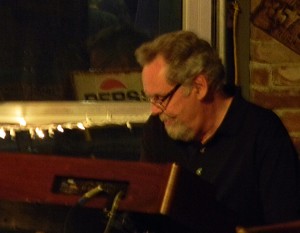 have Reese Wynans, the keyboardist who played with Stevie for the last five years of the great guitarist’s life, as a special guest speaker/performer. Reese was kind enough to share his story with me and a room full of alums at our monthly Nashville Berklee Jam last Tuesday at The Fillin’ Station.
have Reese Wynans, the keyboardist who played with Stevie for the last five years of the great guitarist’s life, as a special guest speaker/performer. Reese was kind enough to share his story with me and a room full of alums at our monthly Nashville Berklee Jam last Tuesday at The Fillin’ Station.
Almost 20 years before he began working with SRV he was playing in cover bands in his home state of Florida, and he recounted one of his first bands playing five sets a night, six nights a week. Two of the other members were Dickey Betts and Berry Oakley and on their one day off they would play a weekly free jam, adding Duane Allman and Butch Trucks to the mix. Eventually Duane decided to start his own band and stole these key members to form The Allman Brothers.
After spending a few years in San Francisco and working with a still-unknown artist at this time, Boz Scaggs, he returned to Florida for a brief period and then worked the East Coast in a show band for a few years. Reese then migrated to Austin, Texas, a booming town full of blues-infused music by this point of the mid-70s. Of this time, Reese spoke passionately.
“It was really great for me living in Austin…everything was so rootsy…they had a great music scene back there in the 70’s. They had a great blues scene, and a great blues club called ‘Antone’s’…and I would go and sit in at Antone’s anytime I had a chance. I was ending up really lovin’ the blues during this time.”
By 1980 he found himself working for Delbert McClinton, playing on four of his records and touring extensively for the next five years. By 1985, Reese was ready to get off the road, and would have if not for a fateful encounter at the end of his final gig with Delbert. Apparently, Delbert’s sax player had been invited to play on one song of a Stevie Ray Vaughan recording session after Delbert’s concert, and at the last minute Reese was asked to join in as the other keyboardist did not show up. Things went very well at this particular recording session, one which produced the hit, “Look at Little Sister” and Reese was asked to come back and record the following day. By the end of that recording session he was asked if he wanted to join the band. Reese summed up a life lesson from this critical moment,
“When a door opens for you, you’ve got to be willing to walk through it, and then be able to deliver once you get through there.”
The next five years would yield three Grammys, several world tours, and a reintroduction of the blues to the masses –
“We were spokesman for Texas blues…as much as Stevie didn’t want to, BB King had to open for us, because we were just more popular than him. He said “no we can never, BB’s always closing the show”… but finally, we had to headline…I loved playing in that band…we were all totally immersed in the blues, and we felt like were the vanguard of the blues. We were dragging Buddy Guy and Otis Rush into the light and presenting them out on our shows to people who were just hungry for that music…the stuff that we played I thought was shining a light on all the huge blues guitar players that had come before us, and that was a wonderful thing to do, I felt like it was really worthwhile.”
 After Stevie’s tragic passing, Reese wound up in Nashville, TN, a place where he has continued to record and perform on a national level. During the talk, Reese passed around his All Music Discography, which reveals a staggering body of work, including Brooks and Dunn’s 2006 single of the year “Believe”. He offered us some thoughts about the differences between studio and live performance –
After Stevie’s tragic passing, Reese wound up in Nashville, TN, a place where he has continued to record and perform on a national level. During the talk, Reese passed around his All Music Discography, which reveals a staggering body of work, including Brooks and Dunn’s 2006 single of the year “Believe”. He offered us some thoughts about the differences between studio and live performance –
“I like being in the studio, I like playing gigs, I like playing clubs…all you people who do studio work know it’s two different things. Playing a club is really a chance to experiment…a chance to reach out in different directions and really find yourself. The studio isn’t really a place for that. The studio is where you don’t have to play it safe, but you’ve got to do something that’s exactly right for the  song…it’s a place for finding something that works, finding something unique that works.”
song…it’s a place for finding something that works, finding something unique that works.”
After his talk was finished, Reese was gracious enough to perform a set with our house band – a performance that was nothing short of inspired. I’ve heard his playing on many records, but there’s something intangible that you can feel in the heat of live performance that goes beyond a recording, and that was evident on this night. One of the songs we played together was “Little Wing”, a song that he had played on tour with Stevie, back in the day. On this song, Reese seemed to really stretch out in one of those magical musical moments in which time seems to stand still (see video below).
Eventually, this special night had to end, and we said goodbye after a quick photo op. Thanks, Reese, for sharing your wisdom, and for continuing to shine some light on that crown jewel of American music we call the blues.
Have you ever played a gig that seemed to go on forever? I’m not talking about your typical three to four hour bar band performance that occasionally might drag a little in the middle, or some uninspired club gig full of “T n’ A” (tables and ashtrays). No, I’m talking about a gig that goes on for hours and hours, eight hours to be exact, by the end of which you felt like you aged 10 years. A few years back I did a few gigs like this, and lived to tell about it.
With thousands of singers and musicians trying to break into the Nashville nightclub scene and only so many potential gigs, the scene here can be quite competitive. And if you’ve been in Nashville for a while, you know all too well that these clubs are not known for their “great pay”. These two facts combined might cause some players to take on gigs that, in another part of the country, would be laughed 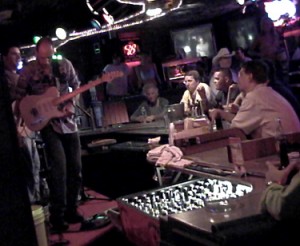 out the door.
out the door.
Don’t get me wrong; there are some club gigs around town that can be lucrative, a few even providing a guarantee of $100 or more per player. But most club gigs in Nashville are tips only, or provide a minimal base pay (usually $20-$50 per player), plus tips. So if you want to make some decent money, you really have to hustle.
Relying on tips causes many club bands to play a three to four hour shift without taking a break, and if a player needs to go to the bathroom the singer might do a few acoustic numbers to provide the band with at least one “pee break”. Relying so greatly on the tip jar for income also causes some singers and bands to exclusively cater to the tourists, choosing worn out dance floor classics like “Margaritaville”, “Sweet Home Alabama” and “Mustang Sally” to keep them happily bopping along.
Several years back I was working pretty steadily downtown, playing a lot of shifts at Tootsies, the Second Fiddle, and a few others on the strip. Around the same time there was another club just a few streets off of Broadway at which I also began performing (to save face, this club will remain anonymous, although its identity will be obvious to anyone who has ever worked this gig). For the purposes of this blog, I will refer to the club owner as “Harry” and the club as “Harry Houdini’s”.
I got to know Harry by hanging out at his club and sitting in on occasion. He liked my playing, and when the guitarist in his weekend house band quit, he offered me the spot. I was hungry for good paying work, and he offered to pay me $125 a night – straight pay with no tips. By Nashville standards, this was great pay for an in-town club gig. There was just one catch – the band was required to play from 7 PM to 3 AM. What?
“Don’t worry, I’ll give you plenty of breaks” Harry assured me. “You can even play sitting on a stool when you get tired”.
Like I said, good paying gigs are hard to find in Nashville, and at this point in time I really needed the dough. Besides, I had already experienced playing some “doubles” on Broadway (for those of you not in the know, this is two shifts back to back, with about a 30 minute break in between shows for change over). The doubles were hard work, but I had built up the necessary stamina, and the extra pay was helping. So what the hell, it can’t be much worse than a double, why not give it a shot?
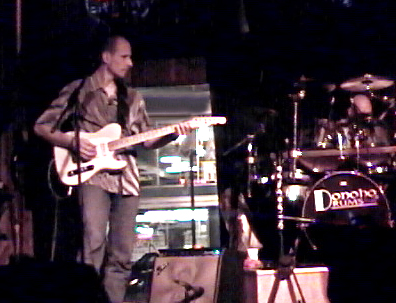 The day of my first gig at this fine establishment I arrived about 20 minutes early, loaded in my gear, and anxiously awaited downbeat. The group consisted of drums, bass, me on guitar, and a singer who also played acoustic. The song list was typical of downtown cover music – classic and new country, pop and rock, and for the first couple of hours, it seemed like just another typical bar gig in Nashville. I even got to take a short break around nine.
The day of my first gig at this fine establishment I arrived about 20 minutes early, loaded in my gear, and anxiously awaited downbeat. The group consisted of drums, bass, me on guitar, and a singer who also played acoustic. The song list was typical of downtown cover music – classic and new country, pop and rock, and for the first couple of hours, it seemed like just another typical bar gig in Nashville. I even got to take a short break around nine.
Then the dynamic of the night began to change. Harry, the club owner, was also a musician, and he came up and sang a set with the band. Some of the songs we played were the previously mentioned classics of “Margaritaville”, “Sweet Home”, and “Mustang Sally”, but we also added to the mix other worn-out wonders like “Brown Eyed Girl”, “Family Tradition”, and the often dreaded “You Never Even Called Me by My Name”.
It was a warm Friday night and the crowd, which seemed to be mainly tourists, seemed happy with what we were doing, we even got a dance floor going. The singer/owner finished his set and went back to work behind the bar, and the other singer came back to take over for a while. Another 45 minutes or so and we got our next pee break while the singer sang a couple tunes solo with his acoustic.
It was now after 11 o’clock, about the average length of a typical bar gig, and Harry again returned to the stage. To my surprise, this next set contained several of the same songs that we played in his first set, most of them being the aforementioned “classics”, a couple of which had also been covered by the other singer.
On our next pee break, sometime around 12:30 AM, I mentioned to the drummer something like “Boy he really likes those oldies. Does he always repeat those songs so much?”
“You ain’t seen nothin’ yet, we’re just getting started. Typically, he wants us to play Margaritaville, Sweet Home, Mustang Sally and Family Tradition about once an hour.” he said to my amazement. “His theory is that the tourists love these songs, and that with the high turnover, it doesn’t really matter how many times we play them.”
Ooookaaay.
Moments later I resumed my perch on the stage to continue my birds-eye view of this top 40 adventure, one that seemed to be entering some kind of classic-hit time warp. I remember looking up at the clock behind the bar a little while later and it reading something like 12:48. Except for the three or four 10 minute pee breaks, I had been playing this gig for about six hours, with two more hours to go, and it began to feel like I had been on the stage for days.
The crowd was now pretty thin, but we marched on. With Harry back on the mic, he asked the crowd “do we have any Lynyrds Skynyrd fans in the house?” With a couple of random cheers forthcoming, we launched into Sweet home Alabama again, now for the fifth time. The same thing happened with some of the other classics. I looked up at the clock a little while later and it was around 1:30. The more we kept repeating songs, the slower the clock seemed to move. At one point my mind flashed to the scene in the movie “Risky Business”, where the character played by Tom Cruise witnesses the clock going backwards right before the bell was supposed to ring.
By the end of the night, I was drenched in sweat and physically and mentally exhausted. My back was sore, my fingers shredded, and my mind numb. We had played Sweet Home Alabama, Mustang Sally, and Family Tradition seven times each throughout the night. Some of the other songs we played four to five times a piece. The funny thing was, the patrons never seemed to notice or care. Harry was right; there was a high turnover, and whatever crowd we had at any given moment seemed to enjoy the songs.
I collected my pay and went home, returning the next evening to do it all over again. As lucrative for an in-town gig as this was, I only lasted a few short weekends before moving onto something else. After a few years I was able to get over my “classic hits overdose”, but for the months following this episode, I suffered severe flashbacks every time somebody called out Sweet Home Alabama and Mustang Sally.
Whether you are a longtime veteran of your local music scene, a recent music school graduate, a hired gun working for a national act, or an aspiring independent artist, you all have something in common – that being a life centered around music. This life of music will lead you into many different performance situations. Like many of my musician friends, I have found myself in a plethora of musical situations over the years; including top 40 bands, rock bands, blues bands, national acts, and start-up original projects, to name a few. I’ve played at festivals, mud bogs, weddings, frat parties, blues jams, jazz jams, open mics, on the Grand Ole Opry, and of course, in nightclubs and bars, the latter being be the arena in which I have probably performed the most.
If there’s one thing I have learned over the years, it’s that you can never have a big enough repertoire. Back in my Berklee days, one of my guitars instructors once told me “You should start building your repertoire of standards. Not only will it help you find your musical voice, it will come in handy down the road”. Twenty-something years and thousands of gigs later, I’ve really come to understand the scope and importance of his words.
Unless you play nothing but your own original music, most live music situations will involve playing a night of cover material, and in my mind, this is a noble cause. The audiences of your typical local bar are usually folks that want to hear some “feel-good music” – familiar, often danceable party tunes that will help them forget about life’s hardships. Before the world had ever heard of “The Beatles”, they were a working cover band, as was Aerosmith, Huey Lewis, and many others.
By the time I entered my nightclub performance years in the late 80s, there was already a few decades of recorded popular music to pick from. Some consider this time period (50s through the 70s) to be the golden era of recorded music. This era gave birth to many songs that are still big crowd-pleasers, those certain tunes that always have a positive impact, no matter what the demographic. While the following decades would add more songs to this pool, it seems that the golden era provides the bulk of what we consider “classic hits” and standards. Over the years, many people have put together lists of the most covered songs, the most popular songs, the greatest hits of all time, etc. In 2004, Rolling Stone Magazine released a list of “500 Greatest Songs of All Time”. Upon scrolling through this list I saw many songs that I had played in different bands and situations over the years.
After cross-referencing that list with the song lists of several modern day cover bands, and comparing that with my own personal experiences, I have come up with a list of what I consider to be songs that every working musician should know. This list is by no means definitive or official; it’s simply my take on the most commonly requested classics, songs that many cover bands have in common, and songs that are often played when guest musicians sit in. Many of these songs are thoroughly worn out and greatly overplayed. Some might argue that many of these tunes have been beaten to death, while others might call this list “Dead Songs That Kill Bands”. Nevertheless, if you are planning on a lifetime of musical performance, knowing these songs, at the absolute least, will come in handy at some point.
| Aint no Sunshine | Bill Withers |
| Ain’t Too Proud to Beg | The Temptations |
| All along the Watchtower | Jimi Hendrix |
| All Right Now | Free |
| Blue Moon Of Kentucky | Patsy Cline |
| Born to Be Wild | Steppenwolf |
| Breakdowm | Tom Petty |
| Brick House | The Commodores |
| Broken Wing | Martina McBride |
| Brown Eyed Girl | Van Morrison |
| Can’t Get Enough | Bad Company |
| Crazy | Patsy Cline |
| Crossroads | Cream |
| Drift Away | Dobi Gray |
| Feelin Allright | Joe Cocker |
| Folsom Prison Blues | Johnny Cash |
| Free Bird | Lynyrd Skynyrd |
| Friends in Low Places | Garth Brooks |
| Georgia | Ray Charles |
| Gimme Three Steps | Lynyrd Skynyrd |
| Good Hearted Woman | Waylon Jennings |
| Hard to Handle | Black Crows |
| He Stopped Loving Her Today | George Jones |
| Hit Me With Your Best Shot | Pat Benatar |
| Honky Tonk Woman | Rolling Stones |
| I Feel Good | James Brown |
| Johnny B Good | Chuck Berry |
| Knock on Wood | Eddie Floyd |
| Knockin on Heavens Door | Bob Dylan |
| Last Chance For Mary Jane | Tom Petty |
| Little Sister | Elvis Presley |
| Long Train Runnin’ | Doobie Brothers |
| Mama Don’t Let Your Babies | Waylon Jennings |
| Margaritaville | Jimmy Buffet |
| Me and Bobby McGee | Janis Joplin |
| Mony Mony | Tommy James & the Shondells |
| Mustang Sally | Wilson Pickett |
| Old Time Rock and Roll | Bob Seger |
| Piece of My Heart | Janis Joplin |
| Pink Houses | John Mellencamp |
| Play That Funky Music | Wild Cherry |
| Pride and Joy | Stevie Ray Vaughn |
| Red House | Jimi Hendrix |
| Redneck Girl | Gretchen Wilson |
| Respect | Aretha Franklin |
| Roadhouse Blues | The Doors |
| Rock ‘n Roll | Led Zeppelin |
| Satisfaction | Rolling Stones |
| Save a Horse Ride a Cowboy | Big and Rich |
| Sittin’ on the Dock of the Bay | Otis Redding |
| Some Kind of Wonderful | Grand Funk Railroad |
| Soulman | Sam and Dave |
| Stand by Your Man | Tammy Wynette |
| Standin On Shaky Ground | Delbert Mcclinton |
| Statesboro Blues | Allman Brothers |
| Stormy Monday | Allman Brothers |
| Summertime | Billy Holiday |
| Superstition | Stevie Wonder |
| Sweet Home Alabama | Lynyrd Skynyrd |
| The Chair | George Strait |
| The Joker | Steve Miller |
| The Thrill Is Gone | BB King |
| Tush | ZZ Top |
| Twist and Shout | The Beatles |
| Walkin’ After Midnight | Patsy Cline |
| What I Like About You | The Romantics |
| Wonderful Tonight | Eric Clapton |
| Workin’ Man Blues | Merle Haggard |
| You Really Got Me | The Kinks |
| You Shook Me All Night Long | ACDC |
Here are a few of what I consider to be the benefits of having a big repertoire of standards:
Requests. If you ever wind up playing some cover gigs, which many musicians do at some point, “standards” will often get requested, and you might find your band “winging” these songs to please audience members. This even happens with national acts.
Sitting in. Having a big repertoire of standards will give you some common ground when sitting in with a band. Back in my New England nightclub days, when friends would sit in with my bands, we would play standards. The same was true when I would sit in with their bands. In Nashville today, sitting in is one of the best ways to build your reputation as a player. Even when superstars sit in, it seems they often choose classic hits or standards over their own material.
Big Tips. If you already play in a cover band, knowing the most popular classics can help you earn some extra tips. I can’t think of how many times someone has said “I’ll give you guys $20 if you play Sweet Home Alabama again.” (Make it an even $50, and it’s a done deal!)
Song Structure. These songs were hits for a reason, and it’s not a coincidence that people still like to hear these songs decades after they were released. Whether it is your desire to be a great performer or a songwriter, internalizing some of these classic hits will teach you song form and structure, and give you perspective about what strikes a chord with the masses.
I would love to hear your thoughts on this list. Are there some songs you feel I missed? Are there songs on here that you think don’t belong? Wherever your musical path might lead, always do your best to smile when playing Mustang Sally, and never accept less than a $20 to play Free Bird!
Have you ever experienced hand or arm pain, or pain in your joints when playing a musical instrument? Perhaps you experience this pain while working at a computer or a mixing console? How about weakness or numbness in your hands or fingers? If you have, or do experience any of these symptoms on a regular basis you are not alone, you, like me, are one of many who live with repetitive motion injuries.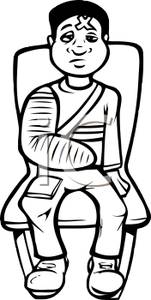
Several years ago, while working on the Toby Keith tour, I was helping the crew load some heavy cases onto a truck. Everything was going fine until one particularly hard-to-maneuver case began to fall off the ramp, with my hand still holding one of the handles. The case didn’t fall completely off the ramp and we were able to pull it back up, but not without my right elbow becoming engulfed in pain. My first thought was that maybe I had sprained something, but I had sprained joints before and they didn’t feel like this. This pain seemed to be centered on my right elbow, and was an intense, burning sensation, like my elbow was on fire. I also felt pain if I squeezed or gripped anything in my right hand. I was instructed by the road manager to get it checked out by a doctor as soon as we returned to Nashville.
At the time of this incident I had already been playing guitar for over 20 years, I had previously worked in construction for several years, and was currently performing a fairly physical job as a guitar tech. All of those years of daily, repetitive hand and arm motions suddenly caught up with me, hurling me full speed into the world of “repetitive motion injuries”. According to the doctors, I had developed tendinitis, and while this incident with the road case may have acted as a trigger, “it had likely been a long time in the making”, they explained. “So how do we heal this?” I asked.
The approach that the doctors chose for me was a regular course of anti-inflammatories, a steroid shot, an arm brace, and the recommendation to “do your best to avoid lifting or gripping anything heavy”, the last piece of advice being somewhat unrealistic for a guitar tech. Although I did follow these recommendations, even adapting some of the physical elements of my job, several weeks later I was still experiencing a lot of pain on a daily basis. It still hurt to grip things with my right hand, and I was beginning to have wrist pain and numbness down my arm. With my situation worsening, the doctors now recommended physical therapy, and this is where I finally began to see some results.
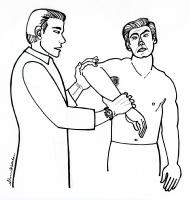 The physical therapist took an entirely different approach. He showed me several hand and arm stretches, which I was instructed to perform daily, he massaged the area of inflammation, and iced it. He showed me how to do the massages myself, and instructed me to do them every morning and night after the stretches, the application of ice always being at the end of the routine. He told me to “listen to my body” and that to perform my regular physical activities as long as they didn’t cause pain. “If an action begins to cause pain, try not to do it.” Making great improvements over the following weeks, I couldn’t understand why the doctors hadn’t recommended any of these approaches. In fact, the doctors did very little to explain the finer points of my affliction, most of what I learned about what causes tendinitis and how to deal with it, I learned from the physical therapist.
The physical therapist took an entirely different approach. He showed me several hand and arm stretches, which I was instructed to perform daily, he massaged the area of inflammation, and iced it. He showed me how to do the massages myself, and instructed me to do them every morning and night after the stretches, the application of ice always being at the end of the routine. He told me to “listen to my body” and that to perform my regular physical activities as long as they didn’t cause pain. “If an action begins to cause pain, try not to do it.” Making great improvements over the following weeks, I couldn’t understand why the doctors hadn’t recommended any of these approaches. In fact, the doctors did very little to explain the finer points of my affliction, most of what I learned about what causes tendinitis and how to deal with it, I learned from the physical therapist.
Over the following months I was able to get an upper hand on my tendinitis, and through regular stretching, didn’t have any more problems for several years. Then I had a setback. One day I was making a homemade pedal board and spent several hours tightly gripping and squeezing a rivet gun. The end result was a resurgence of the pain in my right elbow as intense as that caused by the Toby Keith road case incident. I paid a couple more visits to a physical therapist who was able to help with some soft tissue manipulation, but the biggest thing he did to help me long term was to introduce me to a whole new way of stretching. The following, which I quoted from my book “The Nashville Musicians Survival Guide”, is part of what I learned.
“The muscles in your arms are actually a series of overlapping interconnected muscles, tendons, and ligaments that run from your fingers all the way to your shoulder. It is because of this fact that it is important to also stretch areas of the arm that might not have any pain or problems. Performing stretches that work your wrists, triceps, and shoulders will ultimately help stretch all the muscles and tendons in between.
Stretching an arm with tendinitis is not the same as stretching a healthy arm and requires some caution. Listen to your body. The stretching should cause some sensation but should not be painful. The more you stretch, the more results you will experience. Stretch at regular intervals throughout the day, always making it a point to warm up with some light cardio before your first stretching sequence. (Stretching cold muscles can cause further injury.) If you are gigging, try to stretch before the performance, after the performance, and even in between songs if you have a chance”…
Taken a step further, it only makes sense to stretch and exercise your entire body, as everything is truly connected… the hip bone’s connected to the leg bone, the leg bone’s connected to the…
I was able to eventually get my recent tendinitis flare up under control, but this affliction still haunts me to this day, with a constant effort required to keep it at bay. If I don’t stretch regularly, the pain comes back, and as the body ages it seems like we are more predisposed to injury – gravity is not on our side. That being said, something that has helped me greatly has been an investment in overall physical fitness, health and well-being. I’ve tried a lot of different exercise programs in recent years, my favorite being the “P90X series” of which I have done several rounds. But I must say that yoga seems to be the one exercise that has helped my overall situation the most, it’s absolutely outstanding for overall flexibility.
Eating healthy food doesn’t hurt either. In fact, there are certain foods that increase inflammation, and others that help to decrease inflammation.
Foods that help decrease inflammation:
Foods containing Omega-3 fatty acids like cold water fish, canola oil, and pumpkin seeds; Olive oil, nuts, fruits, vegetables, lean poultry, legumes, tofu, ginger, and some herbal teas
Foods to Avoid
Junk foods, high-fat meats, sugar, and highly processed foods are at the top of this list. Avoid anything that contains high amounts of trans fats and saturated fats like red meat and high-fat processed meats such as bacon and sausage.
For more info on what foods to eat or avoid, follow this link to read the article from which much of this nutritional information was taken, or visit the website, Do It the Hard Way, to learn some nutrition basics and find healthy recipes.
Unfortunately, we live in a society that tends to address problems only as they occur, rather than focusing on prevention. When I think back to all my years of guitar lessons, even my years of music college, no instructor ever told me that repetitive motion injuries exist, let alone how to prevent or deal with them. If you’re a musician and don’t yet have any of these afflictions, it’s obvious that physical fitness and overall health and well-being will reduce your chances of ever having these problems. And if you are “playing with pain”, you’re not alone, there are many of us. But the good news is that most problems are treatable, there are solutions – they just require a little knowledge, a consistent effort, and some self-investment.
“Every human being is the author of his own health or disease.”
— the Buddha
To gain some more perspective on repetitive motion injuries, as well as some of their common misconceptions, follow this link and read “A Cure for Carpal Tunnel Syndrome?” by Jennie Hoeft, as it was reposted on Nashville drummer, Stephen Taylor’s blog.
With my new book “The Nashville Musician’s Survival Guide” finally being out into the world, I’m starting to get my life back again. And going out on the town to network and check out the scene a little more often has now become a little more practical.
Around Town
Last Thursday I went to The Fillin’ Station, in Kingston Springs, for their weekly blues jam. There was a great turnout of talented players and some killer jams took place. For those of you who have never been, the jam is hosted by “The Mohawk Slim Blues Band” and runs every Thursday from 7 – 11 PM. A great place to meet new players, do a little jamming, or just hang that’s outside the in-town microscope – you owe it to yourself to check this place out!
This past Tuesday I went to The Fiddle and Steel Tuesday night jam. As some of you may have previously read, “The Steel” is a great in-town bar and a place that helped me get my start in Nashville. When I first moved to town, Tuesday nights at The Steel were THE place to be, as it was one of the best music industry hangs in the city for the longest time. In recent weeks the jam has been resurrected, and this was the first time I had a chance to check it out. The band started just after 10 PM and the place was packed by 11 PM, with a great turnout of players playing everything from Vince Gill to SRV and Merle Haggard to Jimi Hendrix. Toby Keith and some of his bandmates were hanging out for a bit and I saw several well-known Nashville songwriters there as well. It looks like Tuesday nights at The Steel are on again!
Nashville Musician’s Survival Guide News
Workshops
This coming Monday, August 29, I will be giving a talk about my book and my experiences in Nashville at Indie Connect. For those of you who are unfamiliar with this organization, Indie Connect is a community of independent musicians, singers, bands, songwriters, record labels, music professionals and service providers who come together to support each other by sharing ideas, expertise, contacts and resources.
Where: Indie Connect: 2720 Old Lebanon Rd. Ste.108, Nashville TN 37214
When: 12:00 PM – 2:00 PM
TV Appearances
Last week I was invited by Bryan Cummings to appear on “The Jesse Goldberg Show” on Channel 19, our local community access station. I will be talking about my book and my experiences in Nashville. I’ll post the air time at a later date.
Radio Giveaways
While I was at The Steel the other night I had the pleasure of meeting Darlas Rai, an on-air personality at Nashville’s 103WKDF. When she learned about my book, she offered to do some promotional giveaways on her radio show. During the next few weeks she will be giving away five free copies of my book during her nightly show which can be heard weeknights from 7:00 PM to 11:00 PM, and Saturdays 6:00 PM to 12:00 PM midnight. Listen to her show for details!
Reviews
And lastly, the book just received its first official review. The French country music magazine “No Fences” caught wind of the project and asked me to send a promotional copy for review. I don’t speak French, but judging from some comments in an e-mail from the magazine, the review is a good one. The review is posted here, and while I’m sure there are computer programs that can translate this, if anyone out there can translate this, please let me know via e-mail.
That’s about it for now; I’ve got some other interesting things in the works and will keep you posted. Meanwhile, happy jamming and I’ll talk to you later!
We’ve done a handful of shows with Georgia native, Corey Smith over the years, and Saturday’s performance at the packed Verizon Wireless Amphitheater in Alpharetta, Georgia was another blockbuster. It was a warm summer day when we pulled into the backstage area just after noon, although not quite as over-the-top as the heat and humidity we’ve been experiencing in Nashville this summer. Who would have thought that we would have to travel further south to experience a cooler day! We loaded in and sound checked just after 2 PM and then chilled for a couple of hours while we waited for showtime.
A little while later it was catering, showers, and a quick changeover after opener, Rachel Farley’s set. We hit the stage hard and fast at 7:45, the crowd quickly showing some love for Rhett and band. 40 minutes later, after blazing through a mixture of Rhett’s classic hits and some of his newer charttoppers, and we were putting the final touches on our closer, Kiss My Country Ass, the crowd now on its feet and singing along. The stagehands helped us strike our gear, and it was packed up under the bus in minutes. The guys hung out by the bus enjoying a few cold ones while Corey finished out the night.
Over the years I’ve played many amphitheaters and concert halls across the land, and the Verizon Wireless Amphitheater in Alpharetta is perhaps one of the nicest of them all. Kelly took some great photos throughout the day and during the show. Here’s a few to give you a taste. (Nashville photographer, Dan Harr, also photographed the night and was kind enough to donate some photos, a few of which are also shown below. Dan’s photos are credited accordingly). Left click on a photo to view it full size:
